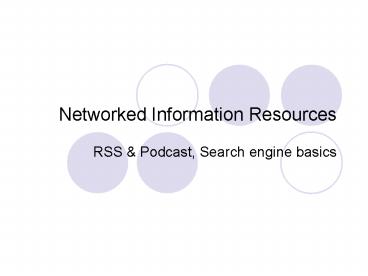Networked Information Resources - PowerPoint PPT Presentation
Title:
Networked Information Resources
Description:
A family of web feed formats used to publish frequently updated digital content, ... or ant) is a program which browses the Web in a methodical, automated manner. ... – PowerPoint PPT presentation
Number of Views:55
Avg rating:3.0/5.0
Title: Networked Information Resources
1
Networked Information Resources
- RSS Podcast, Search engine basics
2
Information access
- Searching
- Browsing
- Filtering
- user profile/personalization/SDI (current
awareness, RSS feed, ) - collective filtering/social filtering (Group
lens, del.icio.us ) - content-based
3
RSS
- Really Simple Syndication
- A family of web feed formats used to publish
frequently updated digital content, such as
blogs, news feeds or podcasts. - http//www.lib.ntu.edu.tw/RSS/nturss.htm
- Podcast from NLM
- RSS Reader/Google reader
- Users of RSS content use programs called feed
"readers" or "aggregators" the user subscribes
to a feed
(Wikipedia)
4
Podcast exercise
- The easy way
- Podcast tutorial (in Chinese!)
- Download 'audacity (to produce audio
programming) - Create a blog
- Post your programs on the blog
- The advanced way
- Edit XML manually, will talk about it later
5
Create your Podcast manually
- 1. Create a website
- 2. Prepare XML file for the RSS/Podcast feed
- 3. Validate the XML file
- http//feedvalidator.org
- rss.scripting.com
- Subscribe the podcast with one of the RSS readers
6
Information is
- Everywhere
- A wealth of information creates a poverty of
attention - Hard to evaluate
- Second-hand knowledge and cognitive authority
- Organic
- Knowledge grows in contexts
- Structured
- Bibliographic, behavioral
- Easy to copy
- First-copy cost, intellectual property
7
Division of intellectual labor
- I know very little about the codes of knowledge
used by the architect and the builder in the
design and construction of the home, but I
nonetheless have faith in what they have done.
My faith is not so much in them, although I
have to trust their competence, as in the
authenticity of the expert knowledge which they
apply something which I cannot usually check
exhaustively myself (Giddens, 1990, The
consequence of Modernity)
8
Second-hand knowledge
- it is not that we have conducted a direct test
of their knowledge. Rather, we have to cite
indirect tests or indexes of credibility. The
situation is one in which we may be faced with a
number of different people all claiming to be
knowledgeable on the subject, how can we choose
among them, or how can we defend our choice once
made? (Wilson, 1983 p.21).
9
How do search engines work?
- They search the internet using crawler/spider
- They keep an index of word/phrases they found
- They allow user to search for words/phrases
10
Crawler
- A web crawler (also known as a web spider or ant)
is a program which browses the Web in a
methodical, automated manner. - Web crawlers are mainly used to create a copy of
all the visited pages for later processing by a
search engine that will index the downloaded
pages to provide fast searches.
(adapted from Wikipedia)
11
More on crawler
- A web crawler is one type of software agent. In
general, it starts with a list of URLs to visit.
As it visits these URLs, it identifies all the
hyperlinks in the page and adds them to the list
of URLs to visit, recursively browsing the Web
according to a set of policies. - Search engine crawler simulator
12
Information retrieval models
- Extract match Boolean logic
- Best match rank search results by relevancy
score
13
Define relevancy
- Location of keywords
- Frequency of keywords (search engine spamming)
- Link analysis PageRank
14
PageRank
- PageRank relies on the uniquely democratic nature
of the web by using its vast link structure as an
indicator of an individual pages value. - In essence, Google interprets a link from page A
to page B as a vote, by page A, for page B. - Important, high-quality sites receive a higher
PageRank, which Google remembers each time it
conducts a search.
15
Cognitive authority and IR
- Two kinds of bibliographic control (Patrick
Wilson) - Describing vs. Exploiting
- Hints of authority (Human information behavior)
- Rational calculation or blind faith
16
The link structure of the Web
- Hubs and authorities
Source Kleinberg and Lawrence (2001). The
Structure of the Web. Science.
17
The link structure of the Web
- Within community link density
Source Kleinberg and Lawrence (2001). The
Structure of the Web. Science.
18
Google desktop
- Google your files stored on your pc and Web pages
you have seen.. - Google Desktop
- More reference on Google Desktop































